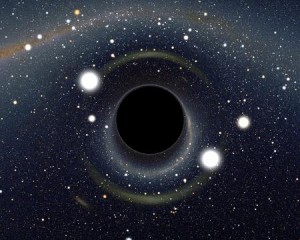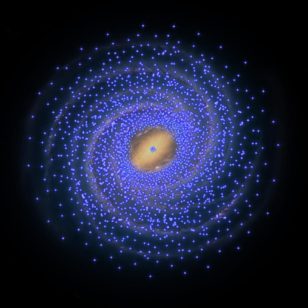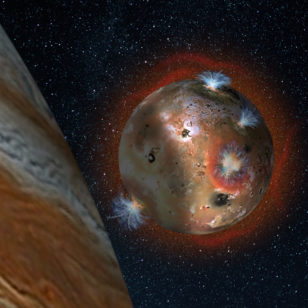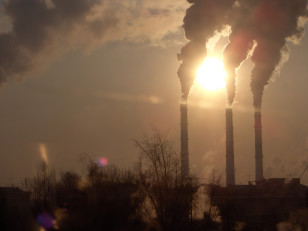
A computer-generated image of the light distortions created by a black hole. (Credit: Alain Riazuelo, IAP/UPMC/CNRS)
Do Black Holes Have Back Doors?
Most people describe a black hole as a cosmic object with gravity so strong that it sucks in any kind of material that comes close to it.
What happens to stuff that is pulled into a black hole?
Some scientists think that matter that enters a black hole gets crushed into a tiny point at the center called a “singularity” and is destroyed.
A new Spanish study proposes that matter may survive its trip into a black hole and then exit out its other side.
The study suggests that the black hole’s singularity could be compared to an imperfection in the geometric structure of space-time such as a wormhole.
According the researchers, after an object enters the black hole it would be stretched or “spaghettified,” which allows it to enter the wormhole. The object would then be restored to its normal size after exiting the wormhole.
Weird Things Happen to Jupiter Moon Io’s Atmosphere Every Day
Scientists, writing in the Journal of Geophysical Research-Planet, have found that the thin atmosphere of Io, one of Jupiter’s major moons, freezes, collapses and turns into surface frost every time it’s eclipsed by the giant planet.
The researchers found that once sunlight returns to Io its atmosphere, then reforms through a process known as sublimation, that’s when material that’s frozen solid quickly changes into gas without first turning into liquid.
The researchers noticed that when Io’s temperatures drop from -113 to -132 degrees Celsius its atmosphere begins to deflate.
As a result of tremendous volcanic activity it has been determined that a majority of Io’s atmosphere is made up of volcanic gases, mostly sulfur-dioxide.
Io, is considered, by scientists, to be the most volcanically active body in the entire solar system.
Jupiter eclipses Io for two hours of its day, every day. One day on Io equals about 1.7 Earth days.

An artist’s impression of the implied distribution of young stars, shown as blue stars, plotted on the background of a drawing of the Milky Way. (University of Tokyo)
Study: No New Stars at Milky Way’s Center
A new study finds a huge region at the center of Milky Way is devoid of young stars.
A team of Japanese, South African and Italian astronomers, writing in the Monthly Notices of the Royal Astronomical Society, found that there are no Cepheid stars an area that extends to some 8,000 light years from our galaxy’s center.
Cepheid stars are said to repeatedly pulsate in brightness and are quite young, between 10 and 300 million years old, compared to our 4.6 billion year old sun.
Astronomer Giuseppe Bono, one of the study’s authors, said their research shows there has been no significant star formation in this large region of the Milky Way for over hundreds of millions years.
The researchers analyzed observations made in the near-infrared light range, since looking for stars so deep in the galaxy can be difficult. Accumulations of interstellar dust can block out light and can hide many stars from view.
Scientists Develop New Method to Convert CO2 into Fuel
A number of studies have linked increases in atmospheric carbon dioxide with global warming and climate change.
Because of this, scientists have focused a lot of their research efforts in trying to reduce the amount of CO2 in the atmosphere.
In process known as photosynthesis, trees and other plant life take CO2 in the air and with help from the sun converts it to sugars that store energy.
Now, a new study from the U.S. Department of Energy’s Argonne National Laboratory and the University of Illinois at Chicago, offers a new method that could allow for the conversion of carbon dioxide into a usable energy source in a manner similar to photosynthesis.
Trees and plants use natural enzymes to help spark the CO2 conversion to sugars.
The study proposes the use of a metal compound called tungsten diselenide to help convert the greenhouse gas into usable fuel such as methanol.

























A big wood ship at Kenturky State,need light from the Legendary Luminatous Pearl?